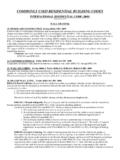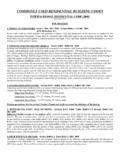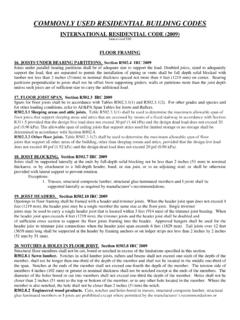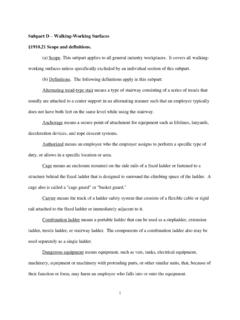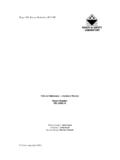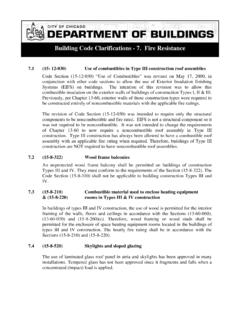Transcription of COMMONLY USED RESIDENTIAL BUILDING CODES
1 COMMONLY used RESIDENTIAL BUILDING CODES INTERNATIONAL RESIDENTIAL code (2009) form revised 5/10 STAIRWAYS 46. LANDINGS. Section R311 IRC 2009 Landings for stairways. There shall be a floor or landing at the top and bottom of each stairway . Exception: A floor or landing is not required at the top of an interior flight of stairs, including stairs in an enclosed garage, provided a door does not swing over the stairs. A flight of stairs shall not have a vertical rise larger than 12 feet (3658 mm) between floor levels or landings. The width of each landing shall not be less than the width of the stairway served. Every landing shall have a minimum dimension of 36 inches (914 mm) measured in the direction of travel.
2 Floors and landings at exterior doors. There shall be a landing or floor on each side of each exterior door. The width of each landing shall not be less than the door served. Every landing shall have a minimum dimension of 36 inches (914 mm) measured in the direction of travel. Exterior landings shall be permitted to have a slope not to exceed 1/4 unit vertical in 12 units horizontal (2-percent). Exception: Exterior balconies less than 60 square feet ( m2) and only accessible from a door are permitted to have a landing less than 36 inches (914 mm) measured in the direction of travel. 47. WIDTH. Section IRC 2009 Stairways shall not be less than 36 inches (914 mm) in clear width at all points above the permitted handrail height and below the required headroom height.
3 Handrails shall not project more than inches (114 mm) on either side of the stairway and the minimum clear width of the stairway at and below the handrail height, including treads and landings, shall not be less than inches (787 mm) where a handrail is installed on one side and 27 (698 mm) where handrails are provided on both sides. Exception: The width of spiral stairways shall be in accordance with Section 48. RISE AND RUN. Section IRC 2009 Walkline. The walkline across winder treads shall be concentric to the curved direction of travel through the turn and located 12 inches (305 mm)from the side where the winders are narrower. The 12-inch (305 mm) dimension shall be measured from the widest point of the clear stair width at the walking surface of the winder.
4 If winders are adjacent within the flight, the point of the widest clear stair width of the adjacent winders shall be used . Stair treads and risers. Stair treads and risers shall meet the requirements of this section. For the purposes of this section all dimensions and dimensioned surfaces shall be exclusive of carpets, rugs or runners. Riser height. The maximum riser height shall be 73/4 inches (196 mm). The riser shall be measured vertically between leading edges of the adjacent treads. The greatest riser height within any flight of stairs shall not exceed the smallest by more than 3/8 inch ( mm). Tread depth. The minimum tread depth shall be 10 inches (254 mm). The tread depth shall be measured horizontally between the vertical planes of the foremost projection of adjacent treads and at a right angle to the tread's leading edge.
5 The greatest tread depth within any flight of stairs shall not exceed the smallest by more than 3/8 inch ( mm). Consistently shaped winders at the walkline shall be allowed within the same flight of stairs as rectangular treads and do not have to be within 3/8 inch ( mm) of the rectangular tread depth. Winder treads shall have a minimum tread depth of 10 inches (254 mm) measured between the vertical planes of the foremost projection of adjacent treads at the intersections with the walkline. Winder treads shall have a minimum tread depth of 6 inches (152 mm) at any point within the clear width of the stair. Within any flight of stairs, the largest winder tread depth at the walkline shall not exceed the smallest winder tread by more than 3/8 inch ( mm).
6 49. PROFILE. Section IRC 2009 The radius of curvature at the leading edge of the tread shall be no greater than 9/16 inch ( mm). A nosing not less than 3/4 inch (19 mm) but not more than 1 1/4 inch (32 mm) shall be provided on stairways with solid risers. The greatest nosing projection shall not exceed the smallest nosing projection by more than 3/8 inch ( mm) between two stories, including the nosing at the level of floors and landings. Beveling of nosing shall not exceed 1/2 inch ( mm). Risers shall be vertical or sloped from the underside of the leading edge of the tread above at an angle not more than 30 ( rad) degrees from the vertical.
7 Open risers are permitted, provided that the opening between treads does not permit the passage of a 4-inch diameter (102 mm) sphere. Exceptions: 1. A nosing is not required where the tread depth is a minimum of 11 inches (279 mm). 2. The opening between adjacent treads is not limited on stairs with a total rise of 30 inches (762 mm) or less. 50. HEADROOM. Section IRC 2009 Headroom. The minimum headroom in all parts of the stairway shall not be less than 6 feet 8 inches (2032 mm) measured vertically from the sloped line adjoining the tread nosing or from the floor surface of the landing or platform on that portion of the stairway . Exception: Where the nosings of treads at the side of a flight extend under the edge of a floor opening through which the stair passes, the floor opening shall be allowed to project horizontally into the required headroom a maximum of 43/4 inches (121 mm).
8 51. SPACE UNDER STAIRS. Section IRC 2009 Under stair protection. Enclosed accessible space under stairs shall have walls, under-stair surface and any soffits protected on the enclosed side with 1/2-inch ( mm) gypsum board. 52. HANDRAILS. Section IRC 2009 Handrails. Handrails shall be provided on at least one side of each continuous run of treads or flight with four or more risers. Height. Handrail height, measured vertically from the sloped plane adjoining the tread nosing, or finish surface of ramp slope, shall be not less than 34 inches (864 mm) and not more than 38 inches (965 mm). Exceptions: 1. The use of a volute, turnout or starting easing shall be allowed over the lowest tread.
9 2. When handrail fittings or bendings are used to provide continuous transition between flights, the transition from handrail to guardrail, or used at the start of a flight, the handrail height at the fittings or bendings shall be permitted to exceed the maximum height. Continuity. Handrails for stairways shall be continuous for the full length of the flight, from a point directly above the top riser of the flight to a point directly above lowest riser of the flight. Handrail ends shall be returned or shall terminate in newel posts or safety terminals. Handrails adjacent to a wall shall have a space of not less than 1 1/2 inch (38 mm) between the wall and the handrails. Exceptions: 1. Handrails shall be permitted to be interrupted by a newel post at the turn.
10 2. The use of a volute, turnout, starting easing or starting newel shall be allowed over the lowest tread. Handrail grip size. All required handrails shall be of one of the following types or provide equivalent graspability. 1. Type I. Handrails with a circular cross section shall have an outside diameter of at least 11/4 inches (32 mm) and not greater than 2 inches (51 mm). If the handrail is not circular, it shall have a perimeter dimension of at least 4 inches (102 mm) and not greater than 61/4 inches (160 mm) with a maximum cross section of dimension of 2 1/4 inches (57 mm). Edges shall have a minimum radius of inch ( mm). 2. Type II. Handrails with a perimeter greater than 6 1/4 inches (160 mm) shall provide a graspable finger recess area on both sides of the profile.
